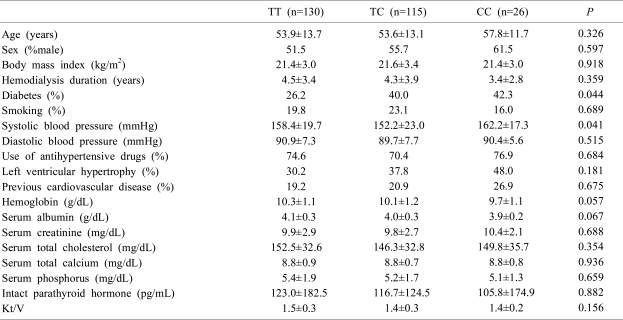1. Perry HM Jr., Miller JP, Fornoff JR, et al. Early predictors of 15-year end-stage renal disease in hypertensive patients. Hypertension. 1995; 25:587–594. PMID:
7721402.

2. Klag MJ, Whelton PK, Randall BL, et al. Blood pressure and end-stage renal disease in men. N Engl J Med. 1996; 334:13–18. PMID:
7494564.

3. Hata A. Role of angiotensinogen in the genetics of essential hypertension. Life Sci. 1995; 57:2385–2395. PMID:
8847959.

4. Niu T, Chen X, Xu X. Angiotensin converting enzyme gene insertion/deletion polymorphism and cardiovascular disease. Drugs. 2002; 62:977–993. PMID:
11985486.

5. Schmidt S, Beige J, Walla-Friedel M, Michel MC, Sharma AM, Ritz E. A polymorphism in the gene for the angiotensin II type 1 receptor is not associated with hyperension. J Hypertens. 1997; 15:1385–1388. PMID:
9431842.
6. Davies E, Kenyon CJ. CYP11B2 polymorphisms and cardiovascular risk factor. J Hypertens. 2003; 21:1249–1253. PMID:
12817167.
7. Clyne CD, Zhang Y, Slutsker L, Mathis JM, White PC, Rainey WE. Angiotensin II and potassium regulate human CYP11B2 transcription through common cis-elements. Mol Endocrinol. 1997; 11:638–649. PMID:
9139807.

8. Russo P, Siani A, Venezia A, et al. Interaction between the C(-344)T polymorphism of CYP11B2 and age in the regulation of blood pressure and plasma aldosterone levels: cross-sectional and longitudinal findings of the Olivetti Prospective Heart Study. J Hypertens. 2002; 20:1785–1792. PMID:
12195120.

9. Davies E, Holloway CD, Ingram MC, et al. Aldosterone excretion rate and blood pressure in essential hypertension are related to polymorphic differences in the aldosterone synthase gene CYP11B2. Hypertension. 1999; 33:703–707. PMID:
10024332.
10. Kumar NN, Benjafield AV, Lin RC, Wang WY, Stowasser M, Morris BJ. Haplotype analysis of aldosterone synthase gene (CYP11B2) polymorphisms shows association with essential hypertension. J Hypertens. 2003; 21:1331–1337. PMID:
12817181.

11. Brand E, Chatelain N, Mulatero P, et al. Structural analysis and evaluation of the aldosterone synthase gene in hypertension. Hypertension. 1998; 32:198–204. PMID:
9719043.

12. Tamaki S, Iwai N, Tsujita Y, Kinoshita M. Genetic polymorphism of CYP11B2 gene and hypertension in Japanese. Hypertension. 1999; 33:266–270. PMID:
9931115.
13. Kupari M, Hautanen A, Lankinen L, et al. Associations between human aldosterone synthase (CYP11B2) gene polymorphisms and left ventricular size, mass, and function. Circulation. 1998; 97:569–575. PMID:
9494027.

14. White PC, Hautanen A, Kupari M. Aldosterone synthase (CYP11B2) polymorphisms and cardiovascular function. Endocr Res. 1998; 24:797–804. PMID:
9888580.

15. Lovati E, Richard A, Frey BM, Frey FJ, Ferrari P. Genetic polymorphisms of the renin-angiotensin-aldosterone system in end-stage renal disease. Kidney Int. 2001; 60:46–54. PMID:
11422735.

16. Fabris B, Bortoletto M, Candido R, et al. Genetic polymorphisms of the renin-angiotensin-aldosterone system and renal insufficiency in essential hypertension. J Hypertens. 2005; 23:309–316. PMID:
15662219.

17. Sokolow M, Lyon TP. The ventricular complex in left ventricular hypertrophy as obtained by unipolar precordial and limb leads. Am Heart J. 1949; 37:161–186. PMID:
18107386.

18. Kang BY, Bae JS, Kim KT, Lee KO. DNA polymorphisms of the human CYP11B2 and γ subunit of ENaC genes in Korean hypertensives. Environ Mutagen Carcinog. 2002; 22:223–228.
19. Ryu SK, Park HY, Im EK, et al. The effects of an aldosterone synthase (CYP11B2) gene polymorphism on the risk of myocardial infarction. Korean Circ J. 2001; 31:1261–1266.

20. Ryu SK, Cho EY, Park HY, et al. Renin-angiotensin-aldosterone system (RAAS) gene polymorphism as a risk factor of coronary in-stent restenosis. Yonsei Med J. 2002; 43:461–472. PMID:
12205735.

21. Sookoian S, Gianotti TF, Gonzalez CD, Pirola CJ. Association of the C-344T aldosterone synthase gene variant with essential hypertension: a meta-analysis. J Hypertens. 2007; 25:5–13. PMID:
17143166.

22. Cheng X, Xu G. Association between aldosterone synthase CYP11B2 polymorphism and essential hypertension in Chinese: a meta-analysis. Kidney Blood Press Res. 2009; 32:128–140. PMID:
19407459.

23. Sookoian S, Gianotti TF, Pirola CJ. Role of the C-344T aldosterone synthase gene variant in left ventricular mass and left ventricular structure-related phenotypes. Heart. 2008; 94:903–910. PMID:
17698557.

24. Pojoga L, Gautier S, Blanc H, et al. Genetic determination of plasma aldosterone levels in essential hypertension. Am J Hypertens. 1998; 11:856–860. PMID:
9683048.

25. Hautanen A, Toivanen P, Manttari M, et al. Joint effects of an aldosterone synthase (CYP11B2) gene polymorphism and classic risk factors on risk of myocardial infarction. Circulation. 1999; 100:2213–2218. PMID:
10577993.


